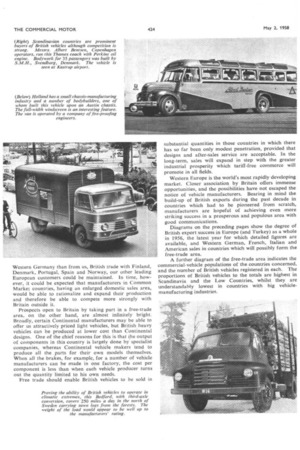BRITAIN PREP ES FOR EUROPI FREE TRAI
Page 114

Page 115

Page 116

If you've noticed an error in this article please click here to report it so we can fix it.
BY 1970, six Continental countries will be trading with no tariffs placed on the entry of each other's goods. They include Western Germany, France and Italy, who in 1956 together made 20 per cent, more commercial vehicles than the United Kingdom; and Holland and Belgium— two of eight European countries who imported British vehicles in any big quantities in that year.
The association of these nations (of which Luxemburg remains to be mentioned) will form the Common Market. Its establishment is certain. Not quite so assured is the free-trade area, which would comprise the Common Market countries plus five others, including Britain. At a later stage, further nations might join the free-trade area so that it would wholly include Western Europe. Those countries in the free-trade area but without the Common Market would retain tariffs in respect of certain products, but it is likely that sales of vehicles would be progressively liberalized year by year until import duties disappeared altogether.
Negotiations about the formation of a free-trade area are proceeding slowly, and although the British Government, supported by the other two political parties in this endeavour, seek a decision by the end of July, it is not easy to believe that this will be achieved. The terms by which a free-trade area would be established and the timing of its introduction are uncertain. The difficulty largely arises out of allaying French fears about the effect of unprescribed British participation in a freetrade area. Other Common Market countries, however, look outside their boundaries and are eager for tariff-free trade with Britain as a major sales outlet for their goods.
The existence of a Common Market without a free-trade area would not immediately hit British exports seriously. Although Holland and Belgium might be expected to buy more from France and Western Germany than from us, British trade with Finland, Denmark, Portugal, Spain and Norway, our other leading European customers could be maintained. In time, however, it could be expected that manufacturers in Common Market countries, having an enlarged domestic sales area, would be able to rationalize and expand their production and therefore be able to compete more strongly with Britain outside it.
Prospects open to Britain by taking part in a free-trade area, on the other hand, are almost infinitely bright. Broadly, certain Continental manufacturers may be able to offer us attractively priced light vehicles, but British heavy vehicles can be produced at lower cost than Continental designs. One of the chief reasons for this is that the output of components in this country is largely done by specialist companies, whereas Continental vehicle makers tend to produce all the parts for their own models themselves. When all the brakes, for example, for a number of vehicle manufacturers can be made in one factory, the cost per component is less than when each vehicle producer turns out the quantity limited to his own needs.
Free trade should enable British vehicles to be sold in
substantial quantities in those countries in which there has so far been only modest penetration, provided that designs and after-sales service are acceptable. In the long-term, sales will expand in step With the greater industrial prosperity which tariff-free commerce will promote in all fields.
Western Europe is the world's most rapidly developing market. Closer association by Britain offers immense opportunities, and the possibilities have not escaped the notice of vehicle manufacturers. Bearing in mind the build-up of British exports during the past decade in countries which had to be pioneered from scratch, manufacturers are hopeful of achieving even more striking success in a prosperous and populous area with good communications. Diagrams on the preceding pages show the degree of British export success in Europe (and Turkey) as a whole in 1956, the latest year for which detailed figures are available, and Western German, French, Italian and American sales in countries which will possibly form the free-trade area.
A further diagram of the free-trade area indicates the commercial-vehicle populations of the countries concerned, and the number of British vehicles registered in each. The proportions of British vehicles to the totals are highest in Scandinavia and the Low Countries, whilst they are understandably lowest in countries with big vehiclemanufacturing industries.




















































































































































































































































